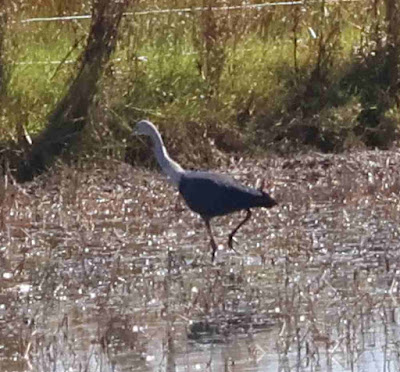A BAD visit to the WTP
On 10 April 4 of us from the Bird a Day (BAD) group visited the Western Treatment Plant at Werribee. Clockwise are Elke (who had the selfie skills to get the snap); me (who had failed miserably at the same task); Faye; and Val.
After meeting at the toilet block we decided that the best place to start was the Crake pond in the T-section ponds, so headed off down Point Wilson Rd. About halfway down the road we stopped to check out 8 Brolgas grazing in a paddock. This gave an incidental sheet.On the drive we had discussed recording strategy. Faye was just doing one list for the whole visit while I was planning to do separate lists for each (loosely defined) main area we visited adding any between sightings to the incidental list.
Once on the way with Elke leading and Faye accepting the role of Official Gate Closer we stopped soon after entering the T-section recording a good bunch of birds in the first pond including Black-fronted Dotterel. Black-tailed Godwit and a handful of late-staying Sharp-tailed Sandpipers. Once at the Crake pond, an Australian Spotted member of that ilk obliged.
And swam across towards us.
4 Cape Barren Geese were also wandering about.
And swam across towards us.
4 Cape Barren Geese were also wandering about.
I ended up with 35 species on my list for this area.
We headed back to the Western Lagoons and paused for a cup of tea etc and the above selfie. Our main hope here was finding some Orange-bellied Parrots sitting on the fence outside the Spit Nature Conservation Reserve. We did see some small parrots briefly on the fence (and then heading towards Austin Rd at Warp Factor 7) but too far away to id to species - and certainly not where such an important species involved - so it is still on my bucket list. There were a lot of hirundines on the fence several of which were clearly Fairy Martins.
Back near the gate a cluster of both Spoonbill species and a Bin Chook were quickly snapped.
A more lonesome Yellow-billed Spoonbill seems to have got lucky in the food department.
Always nice to see Red-necked Avocets - in this case 42 of them, only part of the flock fitted in the image
Our first White-necked Heron, leading to a little discussion of the erratic movement of this species.
We totalled 23 species for this element of the Plant.
Back near the gate a cluster of both Spoonbill species and a Bin Chook were quickly snapped.
A more lonesome Yellow-billed Spoonbill seems to have got lucky in the food department.
Always nice to see Red-necked Avocets - in this case 42 of them, only part of the flock fitted in the image
Our first White-necked Heron, leading to a little discussion of the erratic movement of this species.
We totalled 23 species for this element of the Plant.
We decided that we had time to swing into Lake Borrie, noting that the tide was unfavourable for visiting the Bird Hide. Before going through the gate we spent a fair time looking at raptors feeding over a flooded paddock: Black-shouldered Kite, Swamp Harrier (2 here), Black Kite (5), Brown Falcon and Australian Hobby were added to the list.
Once through the gate we found a Sandpiper - which after much looking we decided was another Sharpie ....
... 2 more Red-kneed Dotterels and a Spotless Crake.
... 2 more Red-kneed Dotterels and a Spotless Crake.
Moving on we found as expected quite a few Musk Duck. 6 Blue-billed Ducks were good and Elke's prediction of Freckled Duck around the posts proved correct to the tune of 17! I must have been getting tired by that point as no pix were taken! On the road out there was a massive flock of Straw-necked Ibis in a damp paddock. I wrote down, as a guess, 1000 birds but that might be half the actual number.
This totalled to 36 species for this element.
A consolidated list of species comes to 65 species for the trip, and I know Faye has at least 1 (European Goldfinch) which I missed.














Comments
Post a Comment